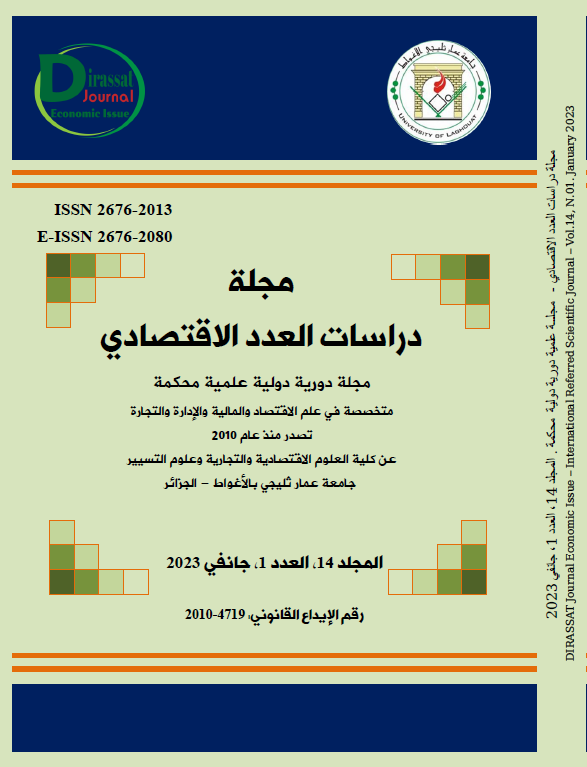The innovation in the elements of the marketing mix and its impact on the preferences of the Algerian consumer for local and foreign smartphones.
Abstract
This study aims at knowing the extent of the impact innovation in the elements of the marketing mix on the preferences of Algerian consumers for local and foreign smartphones based on a hypothetical model that takes the nature of the relationship between innovation in the elements of the marketing mix and consumer preference for the local and foreign smartphone. Two basic hypotheses were built from which a set of sub-hypotheses emerged. We concluded that there is a strong correlation and impact between innovation in the elements of the marketing mix and consumer preferences for smart phones. We reached a set of conclusions and recommendations that highlight the importance of innovation in the elements of the marketing mix in building a preferential base, starting from the sample of this study and arriving at the study community, which is the Algerian market and employing all its elements to make the local product reach the largest possible market segment.
Downloads
References
حكيم خلفاوي. (جانفي, 2015). دور المعرفة السوقية في تحقيق الابتكار التسويقي. مجلة الاقتصاد الجديد، الصفحات 173-192.
خالد قاشي. (1 1, 2015). مساهمت الابتكار انتسويقي في تنمية الميزة التنافسية لمنظماث الأعمال الحديثة دراسة ميدانية لمنظمة سويتلي بمحافظة الجلفة بالجزائر. دراسات العدد الاقتصادي، الصفحات 187-206.
طارق قندوز. (15 01, 2015). فعّالية الابتكار التسويقي في تجويد الخدمة المصرفية -دراسة حالة بنك الفلاحة والتنمية الريفية - وكالة المسيلة-. مجلة الابتكار والتسويق.
محمد إبراهيم عبيدات. (2004). سلوك المستهلك {مدخل استراتيجي}. عمان، الاردن: دار وائل للنشر.
Hakim Khalfaoui. (January, 2015). The role of market knowledge in achieving marketing innovation. Journal of New Economics, pp. 173-192.
Khaled Kashi. (1, 2015). The contribution of marketing innovation to the development of the competitive advantage of modern business organizations, a field study of the Sweetly Organization in Djelfa Governorate, Algeria. Economic Issue Studies, pp. 187-206.
Tariq Kunduz. (15 01, 2015). The effectiveness of marketing innovation in improving the banking service - a case study of the Bank of Agriculture and Rural Development - Al-Masila Agency -. Journal of Innovation and Marketing.
Mohamed Ibrahim Obeidat. (2004). Consumer behavior {strategic entry}. Amman, Jordan: Wael Publishing House
BELK, R. (1975). Situational variables and consumer behavior. Journal of Consumer research, pp. 157-164.
Khan, N., Salam, S., & Sherpao, A. (2014). Impact of Innovation on Customer Satisfaction and Brand Loyalty: A Case Study of Professionals". nternational Journal of Management Sciences, 3, pp. 663-672.
Malviya, S., Saluja, M. S., & Thakur, A. S. (2013, Manminder Singh Saluja. Surendra Malviya). A Study on the Factors Influencing Consumer’s Purchase Decision towards Smartphones in Indore. International Journal of Advance Research in Computer Science and Management Studies, 1(6).
Medrano, N., & Olarte-Pascual, C. (2016, 03 08). The effects of the crisis on marketing innovation: an application for Spain. Journal of business & industrial marketing.
Wardhana, A., Pradana, M., & Hasna, S. (2021). The influence of consumer behavior on purchasing decision process of tokopedia e-commerce customers in Indonesia. Conference on Industrial Engineering and Operations Management (pp. 5929-5934). Singapore: IEOM Society International.
Copyright (c) 2023 Otmani Mohammed Lamine, Ahmed Mahmodi

This work is licensed under a Creative Commons Attribution-NonCommercial 4.0 International License.
















